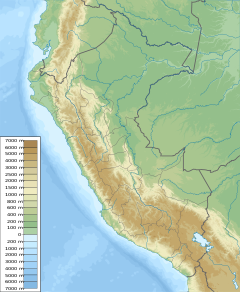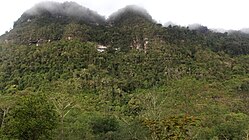
The Andes, Andes Mountains or Andean Mountain Range are the longest continental mountain range in the world, forming a continuous highland along the western edge of South America. The range is 8,900 km (5,530 mi) long, 200 to 700 km wide, and has an average height of about 4,000 m (13,123 ft). The Andes extend from north to south through seven South American countries: Venezuela, Colombia, Ecuador, Peru, Bolivia, Chile and Argentina.
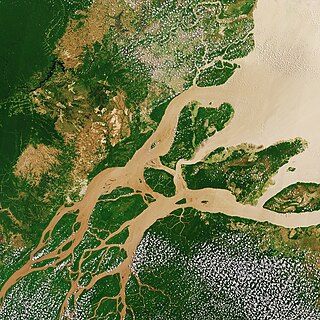
The Amazon River in South America is the largest river by discharge volume of water in the world, and the longest or second-longest river system in the world, a title which is disputed with the Nile.

Iguazú Falls or Iguaçu Falls are waterfalls of the Iguazu River on the border of the Argentine province of Misiones and the Brazilian state of Paraná. Together, they make up the largest waterfall system in the world. The falls divide the river into the upper and lower Iguazu. The Iguazu River rises near the heart of the city of Curitiba. For most of its course, the river flows through Brazil; however, most of the falls are on the Argentine side. Below its confluence with the San Antonio River, the Iguazu River forms the border between Argentina and Brazil.

Ancash is a department and region in western Peru. It is bordered by the departments of La Libertad on the north, Huánuco and Pasco on the east, Lima on the south, and the Pacific Ocean on the west. Its capital is the city of Huaraz, and its largest city and port is Chimbote. The name of the region originates from the Quechua word anqash, from anqas ('blue') or from anka ('eagle').

In geology and physical geography, a plateau, also called a high plain or a tableland, is an area of a highland consisting of flat terrain that is raised sharply above the surrounding area on at least one side. Often one or more sides have deep hills or escarpments. Plateaus can be formed by a number of processes, including upwelling of volcanic magma, extrusion of lava, and erosion by water and glaciers. Plateaus are classified according to their surrounding environment as intermontane, piedmont, or continental. A few plateaus may have a small flat top while others have wider ones.
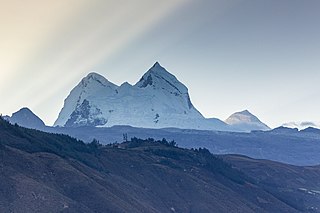
The Cordillera Blanca is a mountain range in Peru that is part of the larger Andes range and extends for 200 kilometres (124 mi) between 8°08' and 9°58'S and 77°00' and 77°52'W, in a northwesterly direction. It includes several peaks over 6,000 metres (19,690 ft) high and 722 individual glaciers. The highest mountain in Peru, Huascarán, at 6,768 metres (22,205 ft) high, is located there.

Iguaçu National Park is a national park in Paraná State, Brazil. It comprises a total area of 185,262.5 hectares and a length of about 420 kilometers (260 mi), 300 kilometers (190 mi) of which are natural borders by bodies of water and the Argentine and Brazilian sides together comprise around 260,000 hectares. Iguaçu National Park was created by federal decree nr. 1035 of 10 January 1939 and became a UNESCO World Heritage Site in 1986. The park is managed by Chico Mendes Institute for Biodiversity Conservation (ICMBio).

Huascarán National Park is a Peruvian national park that comprises most of the mountain range known as Cordillera Blanca which is part of the central Andes, in the region of Ancash. The park covers an area of 340,000 hectares and is managed by the Peruvian Network of Protected Natural Areas, or SERNANP. It was designated as a World Heritage Site in 1985 by UNESCO, is also a well-known mountaineering spot, and harbors a unique biodiversity with plant species such as the Queen of the Andes, trees of the genera Polylepis and Buddleja, and animals such as spectacled bears, condors, vicunas, and tarucas.
Jaén, founded as San Leandro de Jaén and then known as Jerez de la Frontera and finally as Jaén de Bracamoros since April 1549, is a city which is the capital of the Jaén Province in the Cajamarca Region in Peru, located in the high jungle of northern Peru. It is the seat of the Catholic Apostolic Vicariate of St. Francis Xavier, also known as Apostolic Vicariate of Jaén en Peru.

Chachapoyas is a city in northern Peru at an elevation of 2,335 meters (7,661 ft). The city has a population of 32,026 people (2017). Situated in the mountains far from the Peruvian coast, Chachapoyas remains fairly isolated from other regions of Peru. It is served by buses to Chiclayo and Cajamarca, and flights to domestic locations from Chachapoyas Airport.

The Rio Abiseo National Park is located in the San Martín department of Peru. UNESCO pronounced it as Natural and Cultural Heritage of Humanity in 1990. The park is home to many species of flora and fauna, as well as the location of over 30 pre-Columbian archaeological sites. Since 1986, the park has not been open to tourism due to the fragile nature of both the natural and archaeological environment.

Gocta is a perennial waterfall with two drops located in Peru's province of Bongara in Amazonas, approximately 771 kilometres (479 mi) to the northeast of Lima. It flows into the Cocahuayco River. Although the waterfall had been well known to locals for centuries, its existence was not made known to the world until after an expedition made in 2002 by a German, Stefan Ziemendorff, with a group of Peruvian explorers. The waterfall, which can be seen from several kilometers away, has been christened Gocta Falls, after the name of the nearest settlement.

The Guayana Region is an administrative region of eastern Venezuela.

Kuélap or Cuélap is a walled settlement located in the mountains near the towns of María and Tingo, in the southern part of the region of Amazonas, Peru. It was built by the Chachapoyas culture in the 6th century AD on a ridge overlooking the Utcubamba Valley.
Cuispes is one of the 12 districts of the province of Bongará, located in the Amazonas Region in the north of Peru.
Valera is a district of Bongará Province, in the Department of Amazonas, Peru. It includes the villages of San Pablo, Cocahuayco, Cocachimba-La Coca, Nuevo Horizontes and Tingorbamba. The Gocta waterfall, 771 m (2,530 ft) high, is easily accessible from either San Pablo or Cocachimba, which are both accessible by road. The waterfall is a 6 km (3.7 mi). walk on a hiking trail, or by horseback from San Pablo. The capital, San Pablo, is at 1,900 m (6,200 ft) above sea level, and has an idyllic climate. It is lush, with around 1 metre (39 in) of annual rainfall and an average high temperature of 25 °C. It is traversed by the Utcubamba River. It is situated between the cities of Pedro Ruiz Gallo and Chachapoyas.

Lake Sibinacocha is a lake in Peru. It is ranked as the 22nd highest lake in the world. It is located in the Cusco Region, Canchis Province, Pitumarca District. The lake is situated at a height of approximately 4,873 metres (15,988 ft), about 15.19 km long and 2.86 km at its widest point, and drains into the Amazon River. Sibinacocha lies in the Vilcanota Range, south of Chumpe and southwest of Condoriquiña.
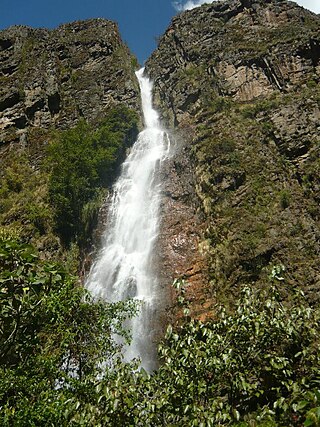
María Jiray is a man-made waterfall located at 3400 meters above sea level, near the town of Acopalca, in the Peruvian region of Ancash. It has an approximate height of 300 meters and is the byproduct of an aqueduct for a nearby hydroelectric plant, as water in excess is diverted to the creek where the waterfall is located. It is a local attraction for trekkers, along with remnants of Andean forests.


